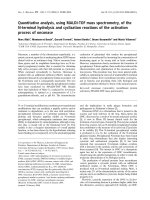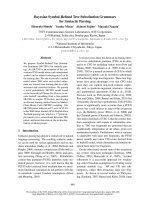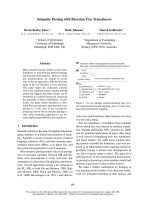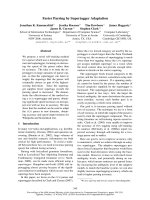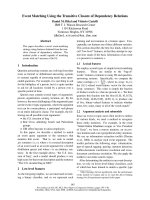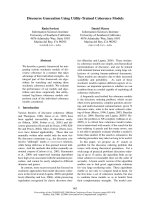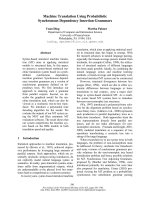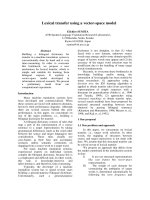Báo cáo khoa học: "Hybrid Parsing: Using Probabilistic Models as Predictors for a Symbolic Parser" docx
Bạn đang xem bản rút gọn của tài liệu. Xem và tải ngay bản đầy đủ của tài liệu tại đây (137.97 KB, 8 trang )
Proceedings of the 21st International Conference on Computational Linguistics and 44th Annual Meeting of the ACL, pages 321–328,
Sydney, July 2006.
c
2006 Association for Computational Linguistics
Hybrid Parsing:
Using Probabilistic Models as Predictors for a Symbolic Parser
Kilian A. Foth, Wolfgang Menzel
Department of Informatics
Universit¨at Hamburg, Germany
{foth|menzel}@informatik.uni-hamburg.de
Abstract
In this paper we investigate the benefit
of stochastic predictor components for the
parsing quality which can be obtained with
a rule-based dependency grammar. By in-
cluding a chunker, a supertagger, a PP at-
tacher, and a fast probabilistic parser we
were able to improve upon the baseline by
3.2%, bringing the overall labelled accu-
racy to 91.1% on the German NEGRA cor-
pus. We attribute the successful integra-
tion to the ability of the underlying gram-
mar model to combine uncertain evidence
in a soft manner, thus avoiding the prob-
lem of error propagation.
1 Introduction
There seems to be an upper limit for the level
of quality that can be achieved by a parser if it
is confined to information drawn from a single
source. Stochastic parsers for English trained on
the Penn Treebank have peaked their performance
around 90% (Charniak, 2000). Parsing of German
seems to be even harder and parsers trained on the
NEGRA corpus or an enriched version of it still
perform considerably worse. On the other hand,
a great number of shallow components like tag-
gers, chunkers, supertaggers, as well as general or
specialized attachment predictors have been devel-
oped that might provide additional information to
further improve the quality of a parser’s output, as
long as their contributions are in some sense com-
plementory. Despite these prospects, such possi-
bilities have rarely been investigated so far.
To estimate the degree to which the desired syn-
ergy between heterogeneous knowledge sources
can be achieved, we have established an exper-
imental framework for syntactic analysis which
allows us to plug in a wide variety of external
predictor components, and to integrate their con-
tributions as additional evidence in the general
decision-making on the optimal structural inter-
pretation. We refer to this approach as hybrid pars-
ing because it combines different kinds of linguis-
tic models, which have been acquired in totally
different ways, ranging from manually compiled
rule sets to statistically trained components.
In this paper we investigate the benefit of ex-
ternal predictor components for the parsing qual-
ity which can be obtained with a rule-based gram-
mar. For that purpose we trained a range of predic-
tor components and integrated their output into the
parser by means of soft constraints. Accordingly,
the goal of our research was not to extensively op-
timize the predictor components themselves, but
to quantify their contribution to the overall pars-
ing quality. The results of these experiments not
only lead to a better understanding of the utility
of the different knowledge sources, but also allow
us to derive empirically based priorities for fur-
ther improving them. We are able to show that
the potential of WCDG for information fusion is
strong enough to accomodate even rather unreli-
able information from a wide range of predictor
components. Using this potential we were able to
reach a quality level for dependency parsing Ger-
man which is unprecendented so far.
2 Hybrid Parsing
A hybridization seems advantageous even among
purely stochastic models. Depending on their
degree of sophistication, they can and must be
trained on quite different kinds of data collections,
which due to the necessary annotation effort are
available in vastly different amounts: While train-
ing a probabilistic parser or a supertagger usually
321
requires a fully developed tree bank, in the case
of taggers or chunkers a much more shallow and
less expensive annotation suffices. Using a set of
rather simple heuristics, a PP-attacher can even be
trained on huge amounts of plain text.
Another reason for considering hybrid ap-
proaches is the influence that contextual factors
might exert on the process of determining the most
plausible sentence interpretation. Since this influ-
ence is dynamically changing with the environ-
ment, it can hardly be captured from available cor-
pus data at all. To gain a benefit from such con-
textual cues, e.g. in a dialogue system, requires to
integrate yet another kind of external information.
Unfortunately, stochastic predictor components
are usually not perfect, at best producing prefer-
ences and guiding hints instead of reliable certain-
ties. Integrating a number of them into a single
systems poses the problem of error propagation.
Whenever one component decides on the input
of another, the subsequent one will most proba-
bly fail whenever the decision was wrong; if not,
the erroneous information was not crucial anyhow.
Dubey (2005) reported how serious this problem
can be when he coupled a tagger with a subsequent
parser, and noted that tagging errors are by far the
most important source of parsing errors.
As soon as more than two components are in-
volved, the combination of different error sources
migth easily lead to a substantial decrease of the
overall quality instead of achieving the desired
synergy. Moreover, the likelihood of conflicting
contributions will rise tremendously the more pre-
dictor components are involved. Therefore, it is
far from obvious that additional information al-
ways helps. Certainly, a processing regime is
needed which can deal with conflicting informa-
tion by taking its reliability (or relative strength)
into account. Such a preference-based decision
procedure would then allow stronger valued evi-
dence to override weaker one.
3 WCDG
An architecture which fulfills this requirement
is Weighted Constraint Dependency Grammar,
which was based on a model originally proposed
by Maruyama (1990) and later extended with
weights (Schr¨oder, 2002). A WCDG models nat-
ural language as labelled dependency trees on
words, with no intermediate constituents assumed.
It is entirely declarative: it only contains rules
(called constraints) that explicitly describe the
properties of well-formed trees, but no derivation
rules. For instance, a constraint can state that de-
terminers must precede their regents, or that there
cannot be two determiners for the same regent,
or that a determiner and its regent must agree in
number, or that a countable noun must have a de-
terminer. Further details can be found in (Foth,
2004). There is only a trivial generator compo-
nent which enumerates all possible combinations
of labelled word-to-word subordinations; among
these any combination that satisfies the constraints
is considered a correct analysis.
Constraints on trees can be hard or soft. Of
the examples above, the first two should proba-
bly be considered hard, but the last two could be
made defeasible, particularly if a robust coverage
of potentially faulty input is desired. When two
alternative analyses of the same input violate dif-
ferent constraints, the one that satisfies the more
important constraint should be preferred. WCDG
ensures this by assigning every analysis a score
that is the product of the weights of all instances
of constraint failures. Parsing tries to retrieve the
analysis with the highest score.
The weight of a constraint is usually determined
by the grammar writer as it is formulated. Rules
whose violation would produce nonsensical struc-
tures are usually made hard, while rules that en-
force preferred but not required properties receive
less weight. Obviously this classification depends
on the purpose of a parsing system; a prescrip-
tive language definition would enforce grammat-
ical principles such as agreement with hard con-
straints, while a robust grammar must allow vio-
lations but disprefer them via soft constraints. In
practice, the precise weight of a constraint is not
particularly important as long as the relative im-
portance of two rules is clearly reflected in their
weights (for instance, a misinflected determiner is
a language error, but probably a less severe one
than duplicate determiners). There have been at-
tempts to compute the weights of a WCDG au-
tomatically by observing which weight vectors
perform best on a given corpus (Schr¨oder et al.,
2001), but weights computed completely automat-
ically failed to improve on the original, hand-
scored grammar.
Weighted constraints provide an ideal interface
to integrate arbitrary predictor components in a
soft manner. Thus, external predictions are treated
322
the same way as grammar-internal preferences,
e.g. on word order or distance. In contrast to a
filtering approach such a strong integration does
not blindly rely on the available predictions but is
able to question them as long as there is strong
enough combined evidence from the grammar and
the other predictor components.
For our investigations, we used the ref-
erence implementation of WCDG available
from ormatik.
uni-hamburg.de/download, which allows
constraints to express any formalizable property
of a dependency tree. This great expressiveness
has the disadvantage that the parsing problem
becomes N P-complete and cannot be solved
efficiently. However, good success has been
achieved with transformation-based solution
methods that start out with an educated guess
about the optimal tree and use constraint failures
as cues where to change labels, subordinations,
or lexical readings. As an example we show
intermediate and final analyses of a sentence from
our test set (negra-s18959): ‘Hier kletterte die
Marke von 420 auf 570 Mark.’ (Here the figure
rose from 420 to 570 DM).
SUBJ
PN
PP
PN
PP
OBJA
DET
S
ADV
hier kletterte die Marke von 420 auf 570 Mark .
In the first analysis, subject and object relations
are analysed wrongly, and the noun phrase ‘570
Mark’ has not been recognized. The analysis is
imperfect because the common noun ‘Mark’ lacks
a Determiner.
PN
ATTR
PP
PN
PP
SUBJ
DET
S
ADV
hier kletterte die Marke von 420 auf 570 Mark .
The final analysis correctly takes ‘570 Mark’ as
the kernel of the last preposition, and ‘Marke’ as
the subject. Altogether, three dependency edges
had to be changed to arrive at this solution.
Figure 1 shows the pseudocode of the best solu-
tion algorithm for WCDG described so far (Foth et
al., 2000). Although it cannot guarantee to find the
best solution to the constraint satisfaction prob-
lem, it requires only limited space and can be in-
terrupted at any time and still returns a solution.
If not interrupted, the algorithm terminates when
A := the set of levels of analysis
W:= the set of all lexical readings of words in the sentence
L := the set of defined dependency labels
E := A × W × W × L = the base set of dependency edges
D := A × W = the set of domains d
a,w
of all constraint variables
B := ∅ = the best analysis found
C := ∅ = the current analysis
{ Create the search space. }
for e ∈ E
if eval(e) > 0
then d
a,w
:= d
a,w
∪ {e}
{ Build initial analysis. }
for d
a,w
∈ D
e
0
= arg max
e∈d
a,w
score(C ∪ {e})
C := C ∪ {e
0
}
B := C
T := ∅ = tabu set of conflicts removed so far.
U := ∅ = set of unremovable conflicts.
i := the penalty threshold above which conflicts are ignored.
n := 0
{ Remove conflicts. }
while ∃ c ∈ eval(C) \ U : penalty(c) > i
and no interruption occurred
{ Determine which conflict to resolve. }
c
n
:= arg max
c∈eval(C)\U
penalty(c)
T := T ∪ {c}
{ Find the best resolution set. }
R
n
:= arg max
R ∈
×
domains(c
n
)
score(replace(C, R))
where replace(C, R) does not cause any c ∈ T
and |R \ C| <= 2
if no R
n
can be found
{ Consider c
0
unremovable. }
n := 0, C := B, T := ∅, U := U ∪ {c
0
}
else
{ Take a step. }
n := n + 1, C := replace(C, R
n
)
if score(C) > score(B)
n := 0, B := C, T := ∅, U := U ∩ eval(C)
return B
Figure 1: Basic algorithm for heuristic transfor-
mational search.
no constraints with a weight less than a prede-
fined threshold are violated. In contrast, a com-
plete search usually requires more time and space
than available, and often fails to return a usable re-
sult at all. All experiments described in this paper
were conducted with the transformational search.
For our investigation we use a comprehensive
grammar of German expressed in about 1,000
constraints (Foth et al., 2005). It is intended to
cover modern German completely and to be ro-
323
bust against many kinds of language error. A large
WCDG such as this that is written entirely by hand
can describe natural language with great precision,
but at the price of very great effort for the grammar
writer. Also, because many incorrect analyses are
allowed, the space of possible trees becomes even
larger than it would be for a prescriptive grammar.
4 Predictor components
Many rules of a language have the character of
general preferences so weak that they are eas-
ily overlooked even by a language expert; for in-
stance, the ordering of elements in the German
mittelfeld is subject to several types of preference
rules. Other regularities depend crucially on the
lexical identity of the words concerned; modelling
these fully would require the writing of a spe-
cific constraint for each word, which is all but in-
feasible. Empirically obtained information about
the behaviour of a language would be welcome
in such cases where manual constraints are not
obvious or would require too much effort. This
has already been demonstrated for the case of
part-of-speech tagging: because contextual cues
are very effective in determining the categories of
ambiguous words, purely stochastical models can
achieve a high accuracy. (Hagenstr¨om and Foth,
2002) show that the TnT tagger (Brants, 2000)
can be profitably integrated into WCDG parsing:
A constraint that prefers analyses which conform
to TnT’s category predictions can greatly reduce
the number of spurious readings of lexically am-
biguous words. Due to the soft integration of the
tagger, though, the parser is not forced to accept its
predictions unchallenged, but can override them if
the wider syntactic context suggests this. In our
experiments (line 1 in Table 1) this happens 75
times; 52 of these cases were actual errors com-
mitted by the tagger. These advantages taken to-
gether made the tagger the by far most valuable in-
formation source, whithout which the analysis of
arbitrary input would not be feasible at all. There-
fore, we use this component (POS) in all subse-
quent experiments.
Starting from this observation, we extended the
idea to integrate several other external compo-
nents that predict particular aspects of syntax anal-
yses. Where possible, we re-used publicly avail-
able components to make the predictions rather
than construct the best predictors possible; it is
likely that better predictors could be found, but
components ‘off the shelf’ or written in the sim-
plest workable way proved enough to demonstrate
a positive benefit of the technique in each case.
For the task of predicting the boundaries of
major constituents in a sentence (chunk parsing,
CP), we used the decision tree model TreeTag-
ger (Schmid, 1994), which was trained on arti-
cles from Stuttgarter Zeitung. The noun, verb
and prepositional chunk boundaries that it predicts
are fed into a constraint which requires all chunk
heads to be attached outside the current chunk, and
all other words within it. Obviously such informa-
tion can greatly reduce the number of structural al-
ternatives that have to be considered during pars-
ing. On our test set, the TreeTagger achieves a
precision of 88.0% and a recall of 89.5%.
Models for category disambiguation can easily
be extended to predict not only the syntactic cate-
gory, but also the local syntactic environment of
each word (supertagging). Supertags have been
successfully applied to guide parsing in symbolic
frameworks such as Lexicalised Tree-Adjoning
grammar (Bangalore and Joshi, 1999). To obtain
and evaluate supertag predictions, we re-trained
the TnT Tagger on the combined NEGRA and
TIGER treebanks (1997; 2002). Putting aside the
standard NEGRA test set, this amounts to 59,622
sentences with 1,032,091 words as training data.
For each word in the training set, the local context
was extracted and encoded into a linear represen-
tation. The output of the retrained TnT then pre-
dicts the label of each word, whether it follows or
precedes its regent, and what other types of rela-
tions are found below it. Each of these predictions
is fed into a constraint which weakly prefers de-
pendencies that do not violate the respective pre-
diction (ST). Due to the high number of 12947 su-
pertags in the maximally detailed model, the ac-
curacy of the supertagger for complete supertags
is as low as 67.6%. Considering that a detailed su-
pertag corresponds to several distinct predictions
(about label, direction etc.), it might be more ap-
propriate to measure the average accuracy of these
distinct predictions; by this measure, the individ-
ual predictions of the supertagger are 84.5% accu-
rate; see (Foth et al., 2006) for details.
As with many parsers, the attachment of prepo-
sitions poses a particular problem for the base
WCDG of German, because it is depends largely
upon lexicalized information that is not widely
used in its constraints. However, such information
324
Reannotated Transformed
Predictors Dependencies Dependencies
1: POS only 89.7%/87.9% 88.3%/85.6%
2: POS+CP 90.2%/88.4% 88.7%/86.0%
3: POS+PP 90.9%/89.1% 89.6%/86.8%
4: POS+ST 92.1%/90.7% 90.7%/88.5%
5: POS+SR 91.4%/90.0% 90.0%/87.7%
6: POS+PP+SR 91.6%/90.2% 90.1%/87.8%
7: POS+ST+SR 92.3%/90.9% 90.8%/88.8%
8: POS+ST+PP 92.1%/90.7% 90.7%/88.5%
9: all five 92.5%/91.1% 91.0%/89.0%
Table 1: Structural/labelled parsing accuracy with
various predictor components.
can be automatically extracted from large corpora
of trees or even raw text: prepositions that tend
to occur in the vicinity of specific nouns or verbs
more often than chance would suggest can be as-
sumed to modify those words preferentially (Volk,
2002).
A simple probabilistic model of PP attachment
(PP) was used that counts only the occurrences of
prepositions and potential attachment words (ig-
noring the information in the kernel noun of the
PP). It was trained on both the available tree banks
and on 295,000,000 words of raw text drawn from
the taz corpus of German newspaper text. When
used to predict the probability of the possible
regents of each preposition in each sentence, it
achieved an accuracy of 79.4% and 78.3%, respec-
tively (see (Foth and Menzel, 2006) for details).
The predictions were integrated into the grammar
by another constraint which disprefers all possible
regents to the corresponding degree (except for the
predicted regent, which is not penalized at all).
Finally, we used a full dependency parser in or-
der to obtain structural predictions for all words,
and not merely for chunk heads or prepositions.
We constructed a probabilistic shift-reduce parser
(SR) for labelled dependency trees using the
model described by (Nivre, 2003): from all avail-
able dependency trees, we reconstructed the se-
ries of parse actions (shift, reduce and attach)
that would have constructed the tree, and then
trained a simple maximum-likelihood model that
predicts parse actions based on features of the cur-
rent state such as the categories of the current
and following words, the environment of the top
stack word constructed so far, and the distance be-
tween the top word and the next word. This oracle
parser achieves a structural and labelled accuracy
of 84.8%/80.5% on the test set but can only predict
projective dependency trees, which causes prob-
lems with about 1% of the edges in the 125,000
dependency trees used for training; in the inter-
est of simplicity we did not address this issue spe-
cially, instead relying on the ability of the WCDG
parser to robustly integrate even predictions which
are wrong by definition.
5 Evaluation
Since the WCDG parser never fails on typical tree-
bank sentences, and always delivers an analysis
that contains exactly one subordination for each
word, the common measures of precision, recall
and f-score all coincide; all three are summarized
as accuracy here. We measure the structural (i.e.
unlabelled) accuracy as the ratio of correctly at-
tached words to all words; the labelled accuracy
counts only those words that have the correct re-
gent and also bear the correct label. For compar-
ison with previous work, we used the next-to-last
1,000 sentences of the NEGRA corpus as our test
set. Table 1 shows the accuracy obtained.
1
The gold standard used for evaluation was de-
rived from the annotations of the NEGRA tree-
bank (version 2.0) in a semi-automatic procedure.
First, the NEGRA phrase structures were auto-
matically transformed to dependency trees with
the DEPSY tool (Daum et al., 2004). However,
before the parsing experiments, the results were
manually corrected to (1) take care of system-
atic inconsistencies between the NEGRA annota-
tions and the WCDG annotations (e.g. for non-
projectivities, which in our case are used only if
necessary for an ambiguity free attachment of ver-
bal arguments, relative clauses and coordinations,
but not for other types of adjuncts) and (2) to re-
move inconsistencies with NEGRAs own annota-
tion guidelines (e.g. with regard to elliptical and
co-ordinated structures, adverbs and subordinated
main clauses.) To illustrate the consequences of
these corrections we report in Table 1 both kinds
of results: those obtained on our WCDG-conform
annotations (reannotated) and the others on the
raw output of the automatic conversion (trans-
1
Note that the POS model employed by TnT was trained
on the entire NEGRA corpus, so that there is an overlap be-
tween the training set of TnT and the test set of the parser.
However, control experiments showed that a POS model
trained on the NEGRA and TIGER treebanks minus the test
set results in the same parsing accuracy, and in fact slightly
better POS accuracy. All other statistical predictors were
trained on data disjunct from the test set.
325
formed), although the latter ones introduce a sys-
tematic mismatch between the gold standard and
the design principles of the grammar.
The experiments 2–5 show the effect of adding
the POS tagger and one of the other predictor com-
ponents to the parser. The chunk parser yields
only a slight improvement of about 0.5% accu-
racy; this is most probably because the baseline
parser (line 1) does not make very many mistakes
at this level anyway. For instance, the relation type
with the highest error rate is prepositional attach-
ment, about which the chunk parser makes no pre-
dictions at all. In fact, the benefit of the PP com-
ponent alone (line 3) is much larger even though
it predicts only the regents of prepositions. The
two other components make predictions about all
types of relations, and yield even bigger benefits.
When more than one other predictor is added to
the grammar, the beneft is generally higher than
that of either alone, but smaller than the sum of
both. An exception is seen in line 8, where the
combination of POS tagging, supertagging and PP
prediction fails to better the results of just POS
tagging and supertagging (line 4). Individual in-
spection of the results suggests that the lexicalized
information of the PP attacher is often counter-
acted by the less informed predictions of the su-
pertagger (this was confirmed in preliminary ex-
periments by a gain in accuracy when prepositions
were exempted from the supertag constraint). Fi-
nally, combining all five predictors results in the
highest accuracy of all, improving over the first
experiment by 2.8% and 3.2% for structural and
labelled accuracy respectively.
We see that the introduction of stochastical in-
formation into the handwritten language model is
generally helpful, although the different predictors
contribute different types of information. The POS
tagger and PP attacher capture lexicalized regular-
ities which are genuinely new to the grammar: in
effect, they refine the language model of the gram-
mar in places that would be tedious to describe
through individual rules. In contrast, the more
global components tend to make the same predic-
tions as the WCDG itself, only explicitly. This
guides the parser so that it tends to check the cor-
rect alternative first more often, and has a greater
chance of finding the global optimum. This ex-
plains why their addition increases parsing accu-
racy even when their own accuracy is markedly
lower than even the baseline (line 1).
6 Related work
The idea of integrating knowledge sources of dif-
ferent origin is not particularly new. It has been
successfully used in areas like speech recognition
or statistical machine translation where acoustic
models or bilingual mappings have to be com-
bined with (monolingual) language models. A
similar architecture has been adopted by (Wang
and Harper, 2004) who train an n-best supertag-
ger and an attachment predictor on the Penn Tree-
bank and obtain an labelled F-score of 92.4%,
thus slightly outperforming the results of (Collins,
1999) who obtained 92.0% on the same sentences,
but evaluating on transformed phrase structure
trees instead on directly computed dependency re-
lations.
Similar to our approach, the result of (Wang
and Harper, 2004) was achieved by integrating
the evidence of two (stochastic) components into
a single decision procedure on the optimal inter-
pretation. Both, however, have been trained on
the very same data set. Combining more than
two different knowledge sources into a system
for syntactic parsing to our knowledge has never
been attempted so far. The possible synergy be-
tween different knowledge sources is often as-
sumed but viable alternatives to filtering or selec-
tion in a pipelined architecture have not yet been
been demonstrated successfully. Therefore, exter-
nal evidence is either used to restrict the space of
possibilities for a subsequent component (Clark
and Curran, 2004) or to choose among the alter-
native results which a traditional rule-based parser
usually delivers (Malouf and van Noord, 2004). In
contrast to these approaches, our system directly
integrates the available evidence into the decision
procedure of the rule-based parser by modifying
the objective function in a way that helps guiding
the parsing process towards the desired interpre-
tation. This seems to be crucial for being able to
extend the approach to multiple predictors.
An extensive evaluation of probabilistic de-
pendency parsers has recently been carried out
within the framework of the 2006 CoNLL
shared task (see />∼
conll). Most successful for many of the 13 dif-
ferent languages has been the system described in
(McDonald et al., 2005). This approach is based
on a procedure for online large margin learning
and considers a huge number of locally available
features to predict dependency attachments with-
326
out being restricted to projective structures. For
German it achieves 87.34% labelled and 90.38%
unlabelled attachment accuracy. These results are
particularly impressive, since due to the strictly lo-
cal evaluation of attachment hypotheses the run-
time complexity of the parser is only O(n
2
).
Although a similar source of text has been used
for this evaluation (newspaper), the numbers can-
not be directly compared to our results since both
the test set and the annotation guidelines differ
from those used in our experiments. Moreover, the
different methodologies adopted for system devel-
opment clearly favour a manual grammar develop-
ment, where more lexical resources are available
and because of human involvement a perfect iso-
lation between test and training data can only be
guaranteed for the probabilistic components. On
the other hand CoNLL restricted itself to the eas-
ier attachment task and therefore provided the gold
standard POS tag as part of the input data, whereas
in our case pure word form sequences are anal-
ysed and POS disambiguation is part of the task
to be solved. Finally, punctuation has been ig-
nored in the CoNLL evaluation, while we included
it in the attachment scores. To compensate for the
last two effects we re-evaluated our parser without
considering punctuation but providing it with per-
fect POS tags. Thus, under similar conditions as
used for the CoNLL evaluation we achieved a la-
belled accuracy of 90.4% and an unlabelled one of
91.9%.
Less obvious, though, is a comparison with re-
sults which have been obtained for phrase struc-
ture trees. Here the state of the art for German is
defined by a system which applies treebank trans-
formations to the original NEGRA treebank and
extends a Collins-style parser with a suffix analy-
sis (Dubey, 2005). Using the same test set as the
one described above, but restricting the maximum
sentence length to 40 and providing the correct
POS tag, the system achieved a labelled bracket
F-score of 76.3%.
7 Conclusions
We have presented an architecture for the fusion of
information contributed from a variety of compo-
nents which are either based on expert knowledge
or have been trained on quite different data col-
lections. The results of the experiments show that
there is a high degree of synergy between these
different contributions, even if they themselves are
fairly unreliable. Integrating all the available pre-
dictors we were able to improve the overall la-
belled accuracy on a standard test set for German
to 91.1%, a level which is as least as good as the
results reported for alternative approaches to pars-
ing German.
The result we obtained also challenges the com-
mon perception that rule-based parsers are neces-
sarily inferior to stochastic ones. Supplied with
appropriate helper components, the WCDG parser
not only reached a surprisingly high level of out-
put quality but in addition appears to be fairly sta-
ble against changes in the text type it is applied to
(Foth et al., 2005).
We attribute the successful integration of dif-
ferent information sources primarily to the funda-
mental ability of the WCDG grammar to combine
evidence in a soft manner. If unreliable informa-
tion needs to be integrated, this possibility is cer-
tainly an undispensible prerequisite for prevent-
ing local errors from accumulating and leading to
an unacceptably low degree of reliability for the
whole system eventually. By integrating the dif-
ferent predictors into the WCDG parsers’s general
mechanism for evidence arbitration, we not only
avoided the adverse effect of individual error rates
multiplying out, but instead were able to even raise
the degree of output quality substantially.
From the fact that the combination of all pre-
dictor components achieved the best results, even
if the individual predictions are fairly unreliable,
we can also conclude that diversity in the selec-
tion of predictor components is more important
than the reliability of their contributions. Among
the available predictor components which could
be integrated into the parser additionally, the ap-
proach of (McDonald et al., 2005) certainly looks
most promising. Compared to the shift-reduce
parser which has been used as one of the pre-
dictor components for our experiments, it seems
particularly attractive because it is able to predict
non-projective structures without any additional
provision, thus avoiding the misfit between our
(non-projective) gold standard annotations and the
restriction to projective structures that our shift-
reduce parser suffers from.
Another interesting goal of future work might
be to even consider dynamic predictors, which
can change their behaviour according to text type
and perhaps even to text structure. This, however,
would also require extending and adapting the cur-
327
rently dominating standard scenario of parser eval-
uation substantially.
References
Srinivas Bangalore and Aravind K. Joshi. 1999. Su-
pertagging: an approach to almost parsing. Compu-
tational Linguistics, 25(2):237–265.
Thorsten Brants, Roland Hendriks, Sabine Kramp,
Brigitte Krenn, Cordula Preis, Wojciech Skut,
and Hans Uszkoreit. 1997. Das NEGRA-
Annotationsschema. Negra project report, Uni-
versit¨at des Saarlandes, Computerlinguistik,
Saarbr¨ucken, Germany.
Sabine Brants, Stefanie Dipper, Silvia Hansen, Wolf-
gang Lezius, and George Smith. 2002. The TIGER
treebank. In Proceedings of the Workshop on Tree-
banks and Linguistic Theories, Sozopol.
Thorsten Brants. 2000. TnT – A Statistical Part-of-
Speech Tagger. In Proceedings of the Sixth Applied
Natural Language Processing Conference (ANLP-
2000), Seattle, WA, USA.
Eugene Charniak. 2000. A maximum-entropy-
inspired parser. In Proc. NAACL-2000.
Stephen Clark and James R. Curran. 2004. The impor-
tance of supertagging for wide-coverage CCG pars-
ing. In Proc. 20th Int. Conf. on Computational Lin-
guistics, Coling-2004.
Michael Collins. 1999. Head-Driven Statistical Mod-
els for Natural Language Parsing. Phd thesis, Uni-
versity of Pennsylvania, Philadephia, PA.
Michael Daum, Kilian Foth, and Wolfgang Menzel.
2004. Automatic transformation of phrase treebanks
to dependency trees. In Proc. 4th Int. Conf. on Lan-
guage Resources and Evaluation, LREC-2004, Lis-
bon, Portugal.
Amit Dubey. 2005. What to do when lexicaliza-
tion fails: parsing German with suffix analysis and
smoothing. In Proc. 43rd Annual Meeting of the
ACL, Ann Arbor, MI.
Kilian Foth and Wolfgang Menzel. 2006. The benefit
of stochastic PP-attachment to a rule-based parser.
In Proc. 21st Int. Conf. on Computational Linguis-
tics, Coling-ACL-2006, Sydney.
Kilian A. Foth, Wolfgang Menzel, and Ingo Schr¨oder.
2000. A Transformation-based Parsing Technique
with Anytime Properties. In 4th Int. Workshop on
Parsing Technologies, IWPT-2000, pages 89 – 100.
Kilian Foth, Michael Daum, and Wolfgang Menzel.
2005. Parsing unrestricted German text with defea-
sible constraints. In H. Christiansen, P. R. Skad-
hauge, and J. Villadsen, editors, Constraint Solv-
ing and Language Processing, volume 3438 of Lec-
ture Notes in Artificial Intelligence, pages 140–157.
Springer-Verlag, Berlin.
Kilian Foth, Tomas By, and Wolfgang Menzel. 2006.
Guiding a constraint dependency parser with su-
pertags. In Proc. 21st Int. Conf. on Computational
Linguistics, Coling-ACL-2006, Sydney.
Kilian Foth. 2004. Writing Weighted Constraints
for Large Dependency Grammars. In Proc. Re-
cent Advances in Dependency Grammars, COLING-
Workshop 2004, Geneva, Switzerland.
Jochen Hagenstr¨om and Kilian A. Foth. 2002. Tagging
for robust parsers. In Proc. 2nd. Int. Workshop, Ro-
bust Methods in Analysis of Natural Language Data,
ROMAND-2002.
Robert Malouf and Gertjan van Noord. 2004. Wide
coverage parsing with stochastic attribute value
grammars. In Proc. IJCNLP-04 Workshop Beyond
Shallow Analyses - Formalisms and statistical mod-
eling for deep analyses, Sanya City, China.
Hiroshi Maruyama. 1990. Structural disambiguation
with constraint propagation. In Proc. 28th Annual
Meeting of the ACL (ACL-90), pages 31–38, Pitts-
burgh, PA.
Ryan McDonald, Fernando Pereira, Kiril Ribarov, and
Jan Hajic. 2005. Non-projective dependency pars-
ing using spanning tree algorithms. In Proc. Human
Language Technology Conference / Conference on
Empirical Methods in Natural Language Process-
ing, HLT/EMNLP-2005, Vancouver, B.C.
Joakim Nivre. 2003. An Efficient Algorithm for Pro-
jective Dependency Parsing. In Proc. 4th Interna-
tional Workshop on Parsing Technologies, IWPT-
2003, pages 149–160.
Helmut Schmid. 1994. Probabilistic part-of-speech
tagging using decision trees. In Int. Conf. on New
Methods in Language Processing, Manchester, UK.
Ingo Schr¨oder, Horia F. Pop, Wolfgang Menzel, and
Kilian Foth. 2001. Learning grammar weights us-
ing genetic algorithms. In Proceedings Eurocon-
ference Recent Advances in Natural Language Pro-
cessing, pages 235–239, Tsigov Chark, Bulgaria.
Ingo Schr¨oder. 2002. Natural Language Parsing with
Graded Constraints. Ph.D. thesis, Dept. of Com-
puter Science, University of Hamburg, Germany.
Martin Volk. 2002. Combining unsupervised and su-
pervised methods for pp attachment disambiguation.
In Proc. of COLING-2002, Taipeh.
Wen Wang and Mary P. Harper. 2004. A statistical
constraint dependency grammar (CDG) parser. In
Proc. ACL Workshop Incremental Parsing: Bringing
Engineering and Cognition Together, pages 42–49,
Barcelona, Spain.
328

